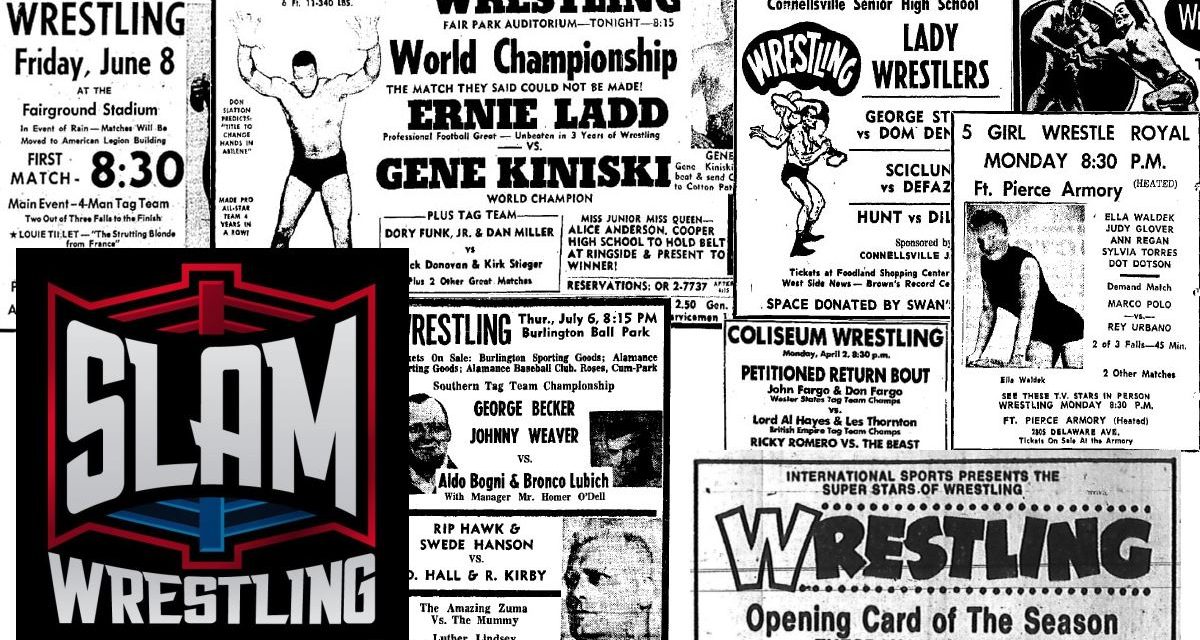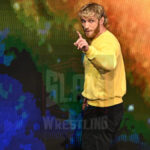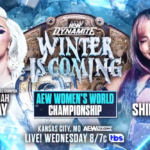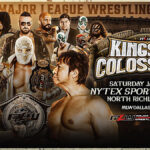Mike Snyder grew up in a family immersed in professional wrestling. His father, the legendary Wilbur Snyder, was an outstanding scientific wrestler during the early 1950s until his retirement in the early 1980s. Throughout Snyder’s childhood, the family moved countless times from California, to Illinois, to Texas, back to Illinois, back to California, to Indiana, to Minnesota, back to California again, and finally back to Indiana. For a few years in the 1970s, Snyder himself gave his best to the professional wrestling business, first as the ring truck driver, then as a ringside photographer, then as a referee, and finally as a high-flying professional wrestler.
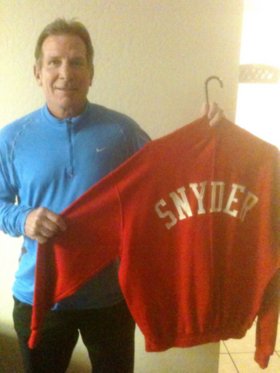
Mike Snyder poses with his Dad’s jacket.
Snyder recently sat down for two interview sessions with SLAM! Wrestling and looked back at his and his father’s wrestling career and beyond.
Ironically, it was another sport that introduced the Snyder family to wrestling. Snyder noted that his father played for the Edmonton Eskimos in the Canadian Football League (CFL) after he played a year for the Los Angeles Rams in the National Football League (NFL). But football would soon give way to wrestling as during his stint in Edmonton, Wilbur’s fellow teammates were Joe Blanchard and Gene Kiniski. The three of them were all interior offensive linemen and at around 240 pounds a piece, they were bigger than anybody else. Their distinct size was soon noticed by a legendary wrestling family.
“Somehow and some way, they got in cahoots with Warren Bockwinkel, Nick Bockwinkel’s father, whom I believe was a wrestling promoter in Los Angeles and convinced all three of them that they should wrestle in the off-season,” explained Snyder.
The elder Bockwinkel convinced the trio they would be making more money wrestling than playing football. In a few short months, Wilbur indeed found his income increasing, so he decided to pursue wrestling full time. Wilbur’s skills and stature as a professional wrestler gained national attention and he appeared on filmed wrestling cards originating from the Hollywood Legion Stadium.
To accommodate Wilbur’s career, the Snyder family moved from Woodland Hills, California to a small, basement apartment in Chicago. Wilbur began working with promoter Fred Kohler, who would also bring in Dick the Bruiser. Wilbur and Bruiser started wrestling each other and drew some large crowds. The two would also go on to be promoters together in Indianapolis and in Chicago with Verne Gagne from the mid-1960s to the early 1980s.
The family would continue to move frequently in those years influenced heavily by Wilbur’s skyrocketing wrestling career. Following that first stint in Chicago, they went to Houston, then back to the Fox Lake area, near Chicago.
“We weren’t usually in a place for a year,” Snyder pointed out.
The Snyder family then moved back to California and then to Minnesota, where Wilbur and Kiniski (Snyder’s godfather) were in the same territory for a while. Snyder vividly remembers a road trip and wrestling match involving his father and Kinski.
“I can remember I could have been 10 or 11 years old,” recalled Snyder. “We traveled 200 miles by car — Gene Kinski, me, and my dad — and we got to the matches. Wilbur and Gene were in the main event in a small town in Indiana. Gene threw Wilbur out of the ring, and (Wilbur) didn’t catch the top rope, splitting his mouth open on a chair needing 15 to 20 stitches. They drove home together laughing about it. I was thinking, ‘Whoa, unbelievable’ with a case of beer between their legs. That’s how they rolled. It was a neat era. It was a different ball game.”
Snyder also recalls a lesser known highlight of Wilbur’s career was his run in San Francisco in the early 1960s, working for Roy Shire. He and Kiniski had some huge matches at the Cow Palace, also with Ray Shire, before he became Ray Stevens.
“As a kid who went to every gosh darn match because Wilbur took me, those were among the most amazing matches I ever saw,” said Snyder. “That was my dad and his partner against the Shire Brothers. I would rank them as high as anybody for performance and creativity of what they did together. It was really mind boggling.”
The family’s final move coincided with Snyder preparing to start high school and Wilbur settling down after over ten years on the road. The family went back to Indianapolis and Wilbur made a point of not moving his family around so that Snyder could be involved in sports. At the Pike High School, Snyder played football, basketball and baseball. Snyder’s sister Cindy ended up meeting her future husband there, fellow wrestler, Steve Regal. After graduation, Snyder stayed relatively close to home and attended Indiana University to play baseball, which was less than one hour’s drive from Indianapolis. After two years, Snyder decided he wasn’t going to end up playing professionally, so he didn’t play his junior and senior year. Snyder ended up meeting his future wife, Sandy, at the school during his sophomore year and graduated in 1970 with a Bachelor’s Degree in Marketing.
With his studies complete, Snyder moved to Aspen, Colorado with aspirations to become a ‘ski bum.’ From there, he went to Hawaii for about seven to eight months, and then came back to marry Sandy in Coeur d’Alene, Idaho, in 1971 on Christmas Day. Snyder was unsure of what the future held for him. He started and ran a rock ‘n’ roll record store for a year. Then he bought a car and moved with Sandy to California, living together with John Isenbarger (of the San Francisco 49ers, who was Snyder’s fraternity brother from university) and his girlfriend for a few months. Snyder says it was there that he decided he had to do something and so he headed back to the Midwest to find out what that something was.

Snyder’s move back to the Midwest put him in a position to obtain employment in the same industry as his father. His father and Bruiser were going to fire the guy who carried the ring, so Snyder agreed to take his place. While doing that gig, Snyder decided to take black and white photographs of the wrestlers since he was attending the matches anyway.
“I had nothing else to do at the matches until it was time to take the ring down,” explained Snyder. “I decided to take pictures of them, and then I’ll develop them. I built a darkroom in my chalet in the country. Sandy’s father was involved in photography and gave me all I needed to develop pictures. So I developed black and white pictures of all the wrestlers and started selling them at the matches at a dollar a piece. I made a lot of money. I made so much money that finally Dick told me he needed a piece of that. I was so pissed off I couldn’t see straight. There was something I built and nobody was doing it, but he (Dick) thought he should take a cut from his partner’s son. You know what? Quite frankly, Wilbur went along with it too. There wasn’t much I could do.”
Snyder decided that his next natural progression in the wrestling business would be becoming a referee. After some experience as a ref, he decided that he should just go all the way and give wrestling a try. Wilbur was hesitant as he both didn’t want his son in the business and wasn’t sure that his son wanted to really be in the business. But a ring was set up in a warehouse and for three weeks Snyder trained with Bobby Heenan and Baron von Raschke.
“We went through everything,” remembered Snyder. “A lot of back flips and a lot of different flips were what I was going to have to do to make a name for myself. I was athletic enough to do that. I was doing summersaults off the top rope, which a lot of people couldn’t do. I enjoyed the wrestling, got started, and found some success. I thought things were doing great. I was undersized for the amount of beatings I took during the course of a match. You do get beat up cause you are thrown all over. I had to take bumps over the top rope. I was easily picked up and body slammed. Overall, I enjoyed it and felt it was a great time of my life.”
The biggest venue Snyder wrestled in was the International Amphitheatre in Chicago. He says that in those days wrestlers were paid with real money and you got paid immediately in the dressing room. His opponents included Mark Manson, Johnny Starr, Mitsu Arakawa, and Heenan.
In 2008, in an interview with SLAM! Wrestling, Johnny Starr remembered Snyder: “We had some really good matches that even the other wrestlers would talk about because we were both smaller guys and were flyers. Mike was by far the best overall athlete. Those matches I had with him did more to launch my career than anything I can think of.”
Looking back now, Snyder says he has examined the pros and cons of being a professional wrestler, with the positives vastly outweighed the negatives.
“I loved it and enjoyed it,” he stated. “I realized I could do it. I was undersized but the story lines put together were good because of Wilbur and my relationship. I interviewed well as I saw that from an early age. As far as upside, you feel at the time that I was not ingrained in the business as veterans like Wilbur and Dick. Don’t ever think this is anything but real wrestling. I did realize you could get your ass kicked as I got thrown all over the place. I didn’t have any major injuries but the wear and tear took its toll.”
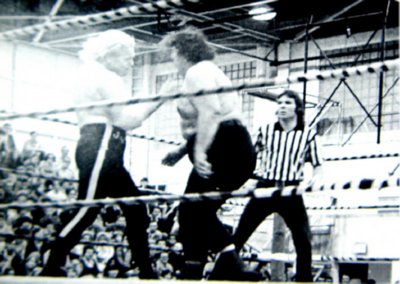
Mike Snyder is the referee in 1973 for a bout between Jimmy Valiant and Moose Cholak. Photo courtesy Richard Vicek Collection
For Snyder, the only downside were negative attitudes about his lineage. But Wilbur always made sure his son was taught how to defend himself in case anyone wanted to harm the promoter’s son. Snyder says these type of incidents only happened a few times. For the majority of the time, the guys he worked with were pretty good guys; they understood him and he understood them.
A potential network TV athletic opportunity would be the beginning of the end for Snyder’s wrestling career. Snyder explains that there used to be a show on ABC called The Superstars, which featured athletes from all different sports competing in a decathlon-like atmosphere. Contestants would compete in different categories by participating in sports like bowling or tennis. Two other wrestlers were supposedly invited to compete and when Snyder caught wind of this, he told Gagne that he wanted to be included.
“Well, what they decided to do was put a competition together amongst wrestlers and it was up in Minneapolis,” he said. “This was all through Verne. He was in contact with somebody and felt this would be great exposure for professional wrestling. I trained in the backwoods of Bloomington and practiced in many events. We all met up in Minneapolis, five of us including Verne’s son, Greg Gagne, Jim Brunzell, and myself. Jimmy Brunzell was a nobody, just getting started but he was a good athlete. Long story short, I won the competition but they wanted two people, so Greg and I were going to get to go.”
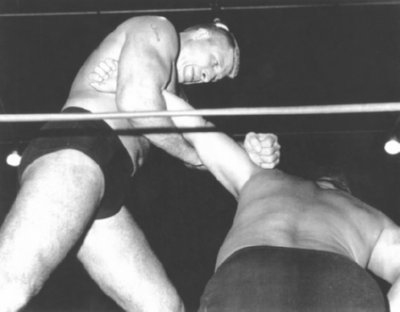
Wilbur Snyder applies an armbar to Mitsu Arakawa in 1966. Photo by Rick Johnson
Mike went full throttle getting himself prepared for this contest, convinced he would win. It just so happened that a few months before the competition his parents ended up owning a condo in a tennis resort down in Pompano Beach, Florida. Wilbur started playing tennis and Snyder, not having played before, knew this was a chance to get better at the game for the competition. Snyder packed up his bags to move down there so he could be trained by his father. After countless hours of training, Snyder was notified that the show didn’t want wrestlers in the competition after all. Snyder was devastated.
The training was not a total waste as Snyder discovered that he actually really liked tennis and wanted to stick with it. On the advice of a trainer, he even decided he could make his living teaching tennis. Right after this epiphany, Snyder received a call to report to Tampa for a wrestling TV taping. The job would have required him to cut himself for a match against Abdullah the Butcher.
“I said I am not driving 250-300 miles up the state, whatever it is, to get my ass cut by Abdullah the Butcher,” admitted Snyder. “That’s not going to happen. I don’t care who is doing the cutting, I am not doing to do it. I did it a couple of times, and Wilbur told me that’s not something you are going to get started on. I just didn’t see the point. The match was going to last a minute or two, so I just decided that this was it. So obviously, I wasn’t booked much after that.”
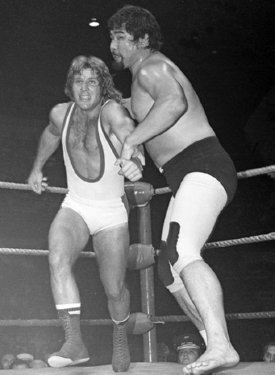
Mike Snyder is shot across the ring by Kim Duk (a.k.a. Tiger Chung Lee). Photo courtesy Bill Ondecko Collection
Snyder decided to become a tennis teacher and got a job at the Fort Lauderdale Yacht Club. Around this time, his first son, Dustin, was born in 1976 (a second son, Dakota, was born in 1980). Unfortunately he was let go by his employer so Snyder and his family moved to Indiana. As it turned out, there weren’t many jobs available teaching tennis. Needing money, Snyder ended up wrestling again for his father for a short time.
Fortunately, Snyder’s passion for tennis presented a golden opportunity to enter the corporate business world. While teaching tennis in Florida, Snyder had met a man who happened to be a big wig at Dow Chemical Company. He approached Snyder telling him that he should use the marketing degree he had obtained and actually work in marketing. He offered to set Snyder up with some interviews in Midland, Michigan.
“I had seven different interviews and then I realized I had no idea how to put on a tie around my neck,” recalled Snyder. “I had no clue whatsoever. I called Wilbur and he stood in front of a mirror (helping me). Long story short, I get hired.”
Snyder was sent to work in San Francisco for about a year and a half after which time he got promoted. He enjoyed getting to see the State of California and traveling all over on somebody else’s dime, but realized that if he was going to be anything big with Dow Chemical, he would have to move to Midland, which he wasn’t willing to do. Snyder started looking around to do something else. He pulled into Sacramento, CA, to call on a client, and ended up in a racquetball club. He took the opportunity to ask if he could play the best racquetball player at the club. He got the name, called the guy and they played within the hour. The opponent and Snyder hit it off and as luck would have it the guy owned an advertising agency. So Snyder was hired onto the advertising staff of a local television station. That game launched his career in media advertising that would go on for 28 years.
While Snyder launched his advertising career, his father Wilbur was winding down his own career and was eventually bought out by partner Dick the Bruiser. Wilbur still had his hand in the business, but he was not fond of the new style of professional wrestling that started to emerge in the early 1980s, especially the open admission that professional wrestling was primarily entertainment. Wilbur always adamantly defended the traditional business against its doubters.
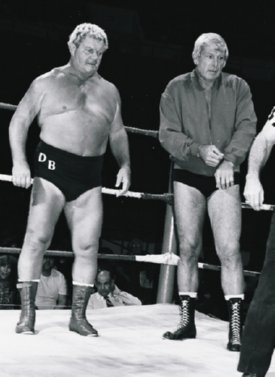
Dick the Bruiser and Wilbur Snyder before a bout in 1981. Photo by Scott Romer
“I have fraternity friends, John Isenbarger, who played professional football, and walked up and asked Is this fake?’ to Wilbur,” Snyder said. “[Isenbarger] was on the ground before he knew it. Wilbur asked him, ‘Do you think that’s fake?’ I remember Wilbur taking down a guy, an amateur wrestler who wrestled at Ohio State. This kid, Tom Cosineau, said, ‘I’ll take your ass down.’ Wilbur put his cigarette down and said, ‘When that burns out, you’ll be upside down, buddy.’ Seconds later, he was upside down.”
About 35 years after he last stepped into the squared circle, Snyder says he does not regret the career path he choose. He says he liked every part of his journey including wrestling, which he describes as a great stepping stone and a way to bond with his father.
“The wrestling part, it was probably more important to me than it was to him,” reflected Snyder. “It was something I wanted to test and see if I could do. I proved it to myself I could do it. I also proved I didn’t need that lifestyle and what it became. Unless you were on top in that game, you couldn’t make the money you needed. Being second tier was nothing I wanted to do with. Athletically, I was okay but those fans wanted to see huge people.”
Wilbur died on December 25, 1991. Discussing his father’s legacy is still difficult for Snyder even after all the years that have passed.
“For being 6 foot 4 inches tall, he (Wilbur) could fly around the ring,” exclaimed Snyder. “He was a unique human being. Probably, his legacy though, this is hard for me. . . He was the nicest man who ever lived. He would do anything for you . . . Give me a second here. . . The friends he accumulated were so beyond wrestling. He could hang with anybody and he did. I never thought this would be this hard.”
A further tribute to Wilbur would be his successful work as a promoter. As a wrestler, Wilbur’s epic bouts with Gagne and Lou Thesz were legendary. It was an exciting and distinguished chapter in the big story of old school professional wrestling just prior to the nationalization efforts by Vince McMahon Jr. and his World Wrestling Federation.
RELATED LINK
Thesz would approve of Wilbur Snyder as a hall of famer
